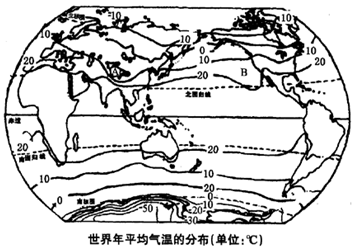读世界年平均气温分布图,回答下列问题:

在图上,找出-10℃和20℃等温线,说明:①世界寒冷地带分布在________;
年平均气温高于20℃的纬度范围主要在_________________(特殊纬线)之间。2. C、D两地中,在夏季________点气温相对较高,为什么?
答:___________________________________________________________
3.A、H两地纬度差不多,而________点气温相对低,为什么?
答:___________________________________________________________________
4.E、F两地中,________点气温很高,为什么?
答:___________________________________________________________________
共8分:
1.两极地区或高纬度地区 南北回归线
2. C C处为内陆,夏季气温高于同纬度海洋
3.A 因为是高山高原 ,海拔高,气温低
4.E 纬度低,气温高
本题主要考查的是气温的相关知识。(1).①世界寒冷地带分布在两极地区或高纬度地区;年平均气温高于20℃的纬度范围主要在南北回归线之间。(2). C、D两地中,在夏季C点气温相对较高,原因是C处为内陆,夏季气温高于同纬度海洋;(3).A、H两地纬度差不多,而A点气温相对低,原因是因为是高山高原 ,
海拔高,气温低;(4).E、F两地中,E点气温很高,原因是纬度低,气温高。
